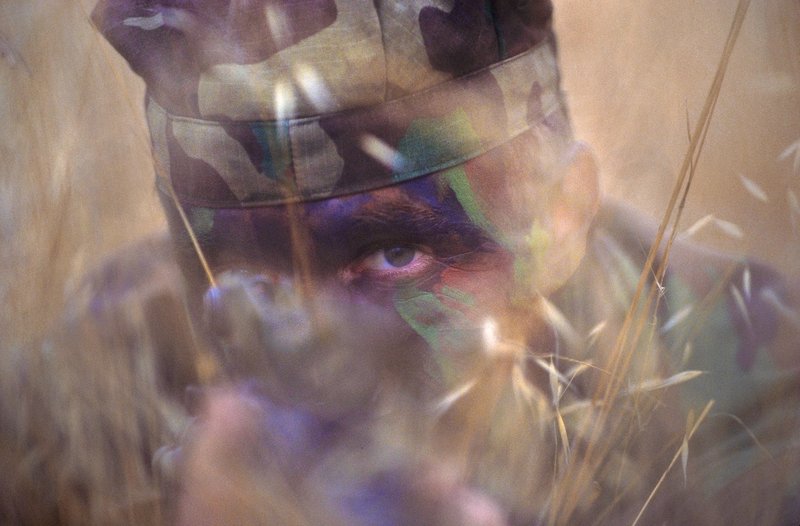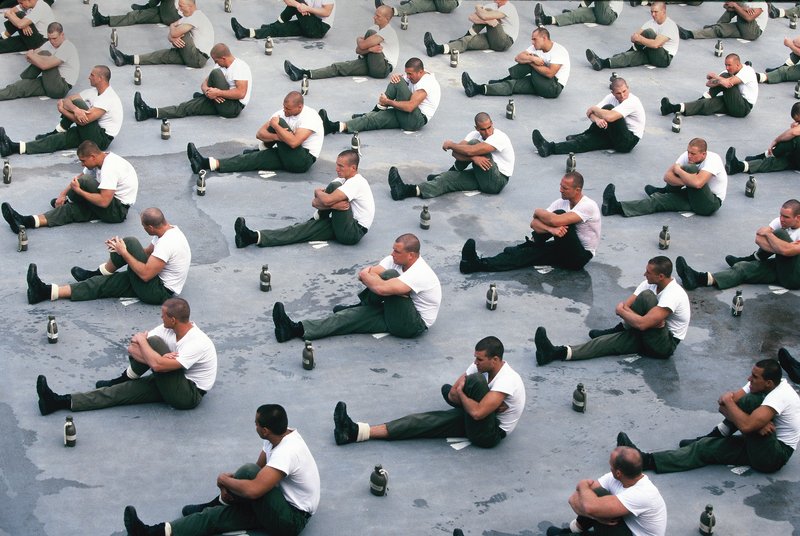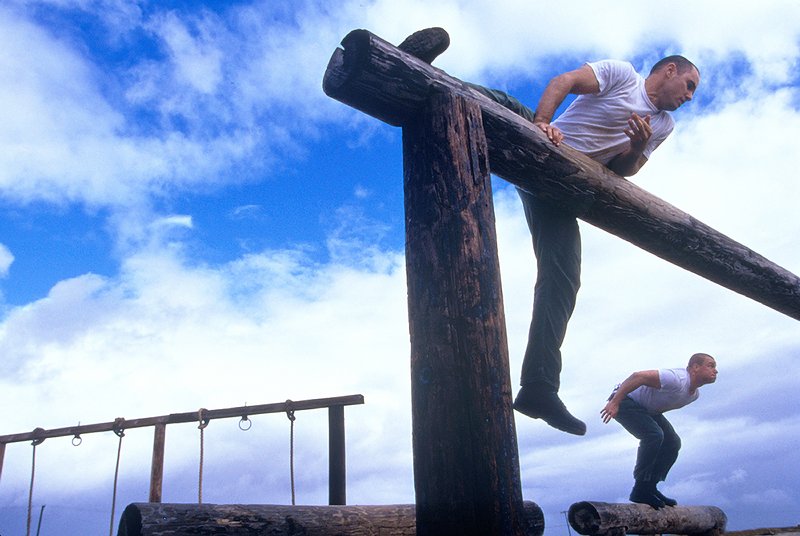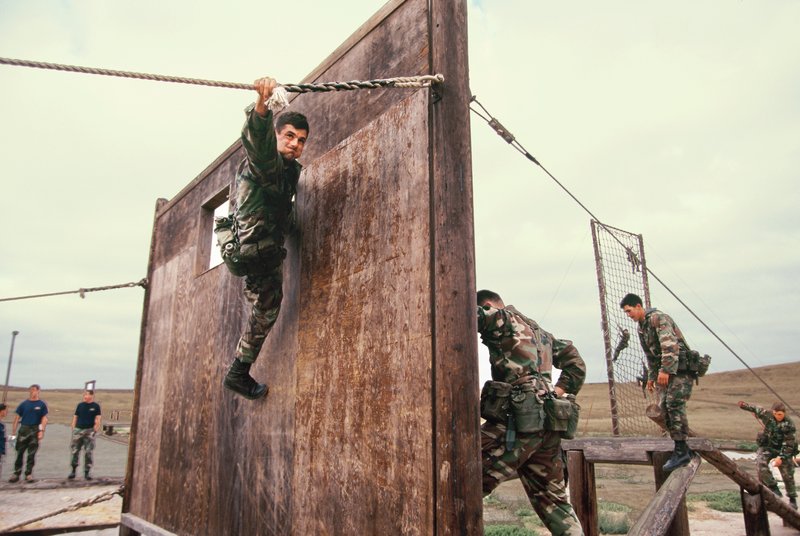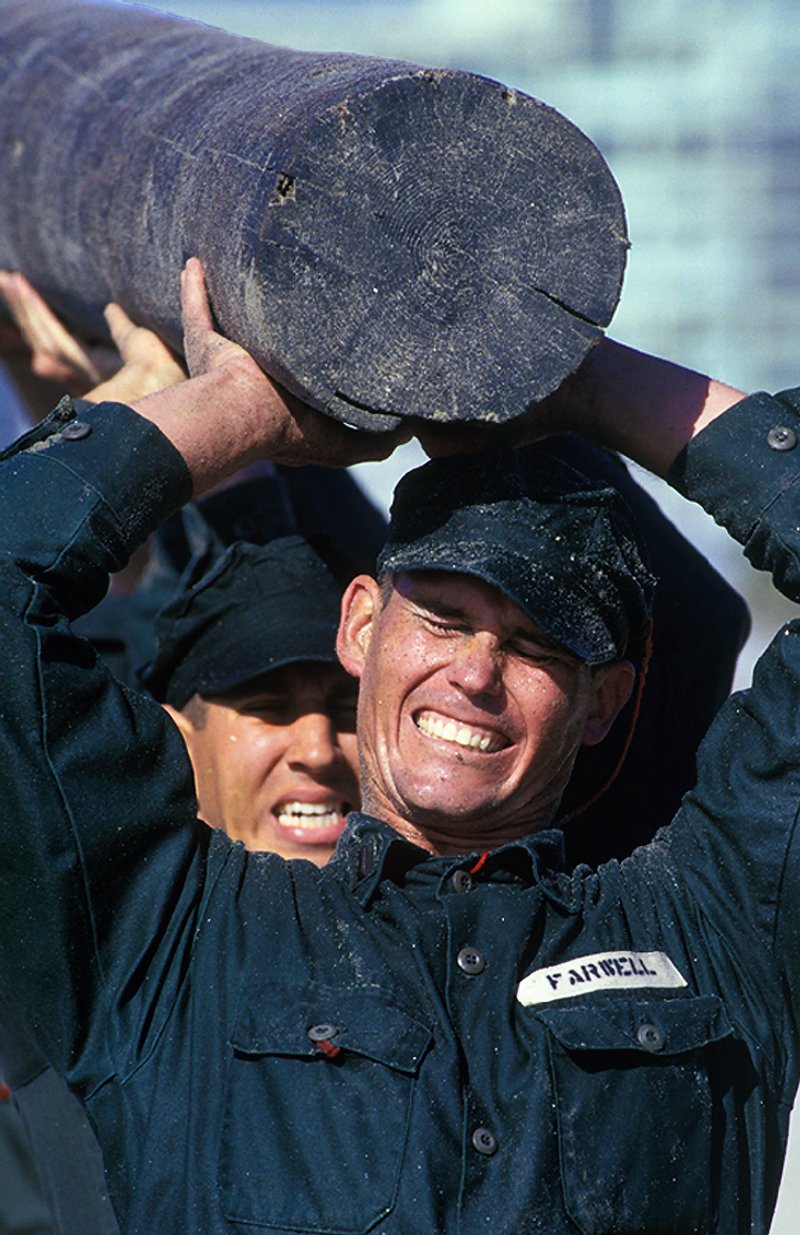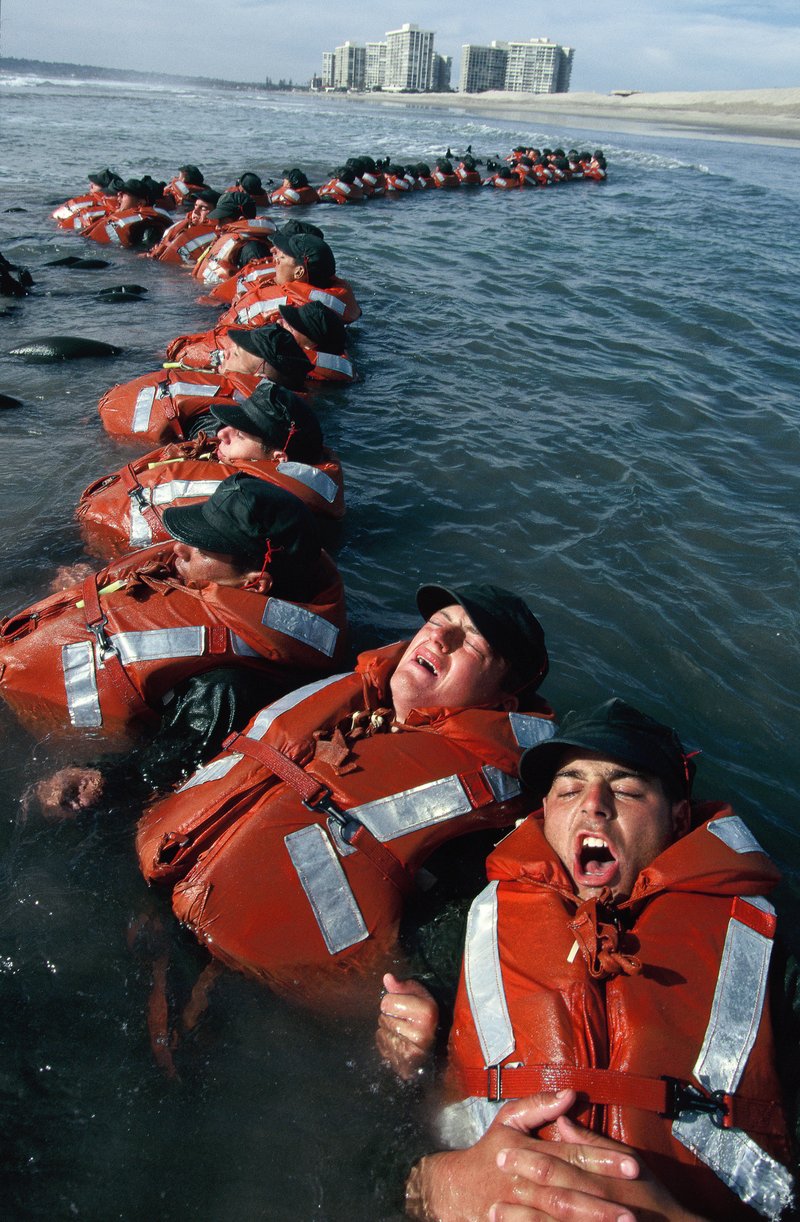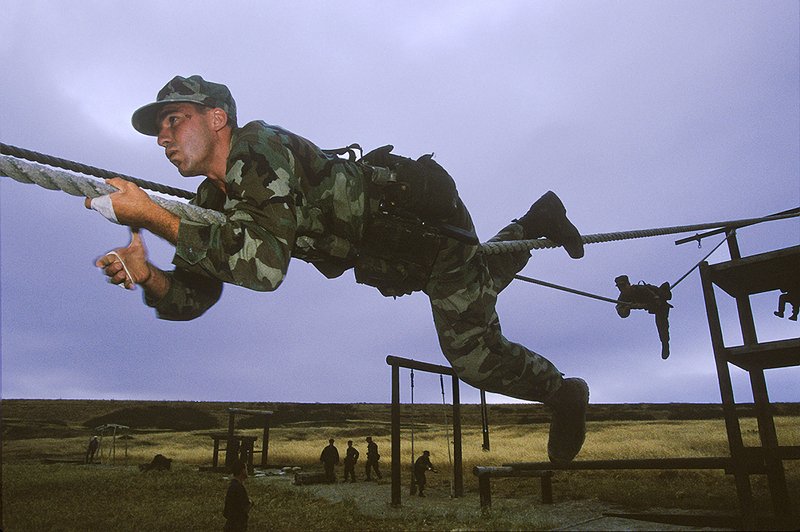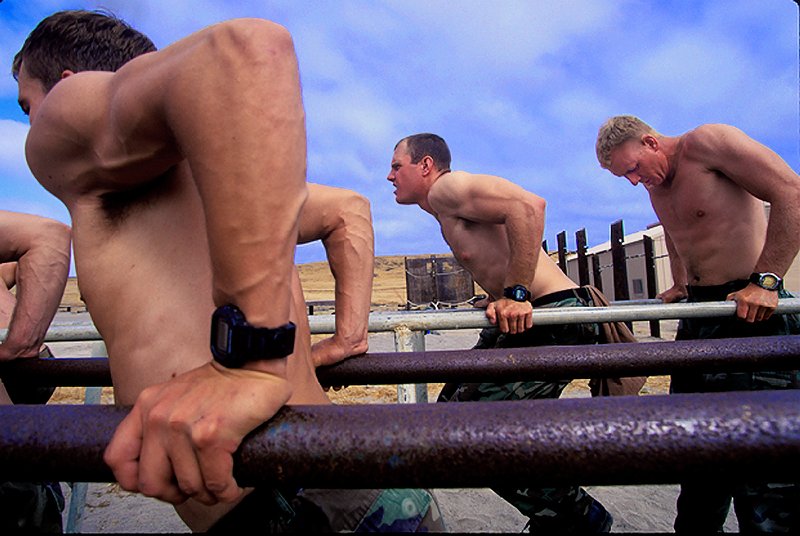Rick Rickman: The Navy Seals Class 211
This story was photographed between
1996 and 1998
The training was carried about at several locations, including the beaches of Coronado, CA; San Diego Bay; San Clemente Island; the Mojave and Anzo Borrego Desert; the San Jacinto Mountains and the Salton Sea.
One hundred and forty-four men of Navy Seal Class 211 from across the nation stand in formation in the assembly courtyard of the Naval Special Warfare Center on Coronado Island in San Diego, California in December of 1997. At the front of the formation of men, Master Chief Gillespie’s voice booms out as he points to a large brass bell next to him on the assembly grounds. “This may become your best friend and salvation.”
“For many of you, it will stop the pain and suffering you will experience during the next 24 weeks of training.”
“When you’ve had enough, just ring the bell and all the pain stops.”
Many of the faces of the 144 showed wide eyes and an intense level of trepidation as heads swiveled around looking to one another. Gillespie barked out one loud command. “Now, get on the deck and give me 50.”
Day 1 of BUDS ( Basic Underwater Demolition/Seal training) had officially begun.
All 144 men dressed in basic green long pants and long sleeve button up shirts and hats (their covers) dropped down and began a rapid process of push-ups as other instructors walked among the ranks screaming at whomever fell behind the pace or performed the push-up positions poorly.
“Would you like me to go ring the bell for you?” One enthusiastic instructor yelled out so everyone could hear clearly.”
“If you can’t even do a proper push-up, how the hell are you ever going to complete this training?”
Other instructors were taking the opportunity to berate other mediocre performances throughout the courtyard. As the push-up process came to conclusion and the 144 sprang back to their feet, Gillespie yelled out, “Follow me and show me some enthusiasm.”
As the group moved out the other five instructors were yelling at the group to form up and berating the ones at the back of the group.
“Are you happy back here?”
“Is that your idea of being a leader?”
The obstacle course became a ritual along with the constant ever increasing number of push-up, pull-ups, sit-ups and flutter kicks. Blisters and rashes became the norm. “I’m finding sand in places that I never thought sand could get to on my body,” said Glen Doherty. “My inner thighs are starting to look like hamburger.”
Class 211 started in December, the water was extremely cold and unfortunately for this class was colder than a normal winter with temperatures of the water reaching 48 degrees on a number of days of training. The air temperature was often in the high 50/low 60 range with wind or constant breeze. The Seal candidates were always wet. “I can’t ever seem to get warm” was a refrain that became constant among the voices coming from the group.
The log felt heavier than it had when they first hoisted it over their heads. Sweat mixed with saltwater dripped into their eyes as they stumbled across the sand, fighting to keep pace. Every step was agony, the sand shifting beneath their boots, threatening to send them crashing to the ground.
“Pick it up, team!” the instructor’s voice was sharp, slicing through the fog of exhaustion.
Kyle’s arms were on fire. His shoulders screamed in protest with each jolting step. Every inch of him wanted to quit, to let the log drop and ring that bell sitting at the edge of the compound. But he wasn’t alone. His teammates were counting on him. If he faltered, they all paid the price.
“Move, move, move!” The instructor barked again.
They picked up speed. Barely. And then, just when Kyle thought it couldn’t get worse, the dreaded words: “Get wet and sandy, gentlemen. Time to be sugar cookies.”
The instructors called it surf torture, and it wasn’t hard to see why. The cold gnawed at Michael’s bones, burrowing deep until it felt like his core was turning to ice. The waves came in rhythmic surges, crashing over their heads, forcing them to gulp air between each onslaught. The cold wasn’t just on his skin now—it was inside him, wrapping its fingers around his heart, sinking into his lungs.
Michael’s muscles began to spasm involuntarily. His limbs felt leaden, stiff, no longer responding to his commands. His body shivered violently, uncontrollably. It was as though his brain had lost the ability to control the chaos happening inside him. He blinked, but his vision was starting to blur.
Next to him, someone groaned. The guy was mumbling, words slurring together. Was it Johnson? Or Miller? He couldn’t tell in the growing darkness. The man’s voice was low, almost pleading. It was always around this point that people started breaking down. The cold stripped away their layers of mental toughness, leaving behind raw, primal fear.
Michael gritted his teeth, forcing his mind to focus on one thing: the next wave. Just survive the next one. And then the one after that. And the one after that.
In that cold, there was only survival. And in the silence between the crashes of the waves, Michael’s quiet voice inside whispered: Don’t give up. Not now. Not yet.
By the end of week one, there were intermittent sound of a bell ringing in the distance.
Timed runs and swims are now a daily occurrence and the timed demands are ever shortened. For those candidates not meeting the times, they are dropped from the training program. There are many forms of punishment handed out to candidates but one of the most effective is to have to lie in the surf zone in the cold water for extended periods. Lying in 49 degree water for 10 minutes will cause all the muscles in your body to tighten up and joints become less likely to respond effectively. Returning to strenuous exercise after a time in cold water can be excruciating, especially when your clothes are still wet and cold.
Initially, the swim training seemed to be one of the more enjoyable aspects of training at the BUDS site. The timed swims were demanding but the waters were temperate at first. As class 211 spent more time in the pool, the instruction became more intense until finally one afternoon learning the technique of drown proofing came into play.
Drown proofing, a very effective survival technique, teaches the candidate how to take a breath, slowly exhaling that air, allowing your body to sink to the bottom, pushing off from the bottom back to the surface, and taking another breath of air. Effectively repeating the process can keep a person alive if stranded for a long period of time.
Learning the technique becomes extensively more complicated and demanding when your hands and feet are tied. If you lose your rhythm or become inverted your chances of drowning are exponentially enhanced. Just watching the restrained training becomes a stressful situation.
By the end of day 3 all members of class 211 were assigned to a 6 or 7 man boat crew according to height. The inflatable boats known as an IBS will became a common site up and down the beaches on Coronado Island.
These newly formed groups are now assigned to one another to man their boats no matter where they go. The purpose of the boat crew arrangement is to teach the candidates how to work together. They are required to learn how to paddle their boat out through intense surf conditions from the beach and once past the surf break zone. They will then turn the boat around and land it safely and effectively on inhospitable terrain. Many candidates may be injured during this training and often boat crews are disciplined for failing to successfully work together to accomplish these tasks.
The punishment is often extended time in the freezing water. The only time the candidates don’t have to hoist their boats is when they are hoisting and running with the waterlogged telephone pole in the sand on the beach. The routines of intense exercise and physical training became constant for the first 3 weeks of participation.
At 1:00 AM at the beginning of the 4th week, candidates are rousted out of their quarters to the sound of screaming and banging in the hallways. They are told to dress and assemble in the courtyard. The boat crews are immediately run down the beach and ordered into the water. The temperature of the water is a crisp 49 degrees and the wind is blowing 10 miles an hour. The boat crews are then ordered to stash their boats securely at a designated location in front of the assembly courtyard.
After stowing their inflatables the men are run down the beach about three miles to a point where a large bonfire is lit. It’s completely dark except for the glow of the firelight. Master Chief Gillespie shouts into a bull horn, “You are all now going to experience “HELL”
The faces of the men are tense and all their eyes are wide and show a sense of real concern. “You will not sleep for 5 days going forward and you will participate in continuous and demanding physical activities designed to seriously test your commitment to our program.
It's the beginning of Hell Week.
Class 211 will now experience one of the most grueling physical and mental testing know to any military service. These men will run more than 200 miles, do more push-up, sit-ups, pull-ups, flutter kicks than are imaginable, as well as perform demanding maneuvering and charting tasks, and swimming continuously in mind numbing, freezing waters for five days on less than 4 hours sleep.
Task #1 is to pick a partner and roll head over heels with your partner through a mile of mud on your way back to command assembly area, jump back into the ocean, retrieve your boat, and then run your crew and your boat to a steel pier on the harbor side of the island about 2 miles away
Task #2 is the strip down to your underwear, get back into the water ( now 48 degrees ) below the pier and tread water for 20 minutes after which time, climb the ladder to the deck of the pier and lay in the breeze ( 8 miles an hour ) for 20 minutes.
Task #3 Repeat task #2! That night, class 211 lost 26 men who rang the bell otherwise known as Drop On Request.
As hell week progressed more and more men dropped out. On night 3, after almost no sleep, the boat crews went to the pool for timed competitive swimming competitions. The men all looked barely conscious now but, Master Chief Gillespie yelled through his megaphone, “Remember our motto. It pays to be a winner.” Just before the competition began. The boat crew who wins gets 10 minutes in the hot water in the showers.
Day Five of hell week started with a half mile run carrying the dreaded waterlogged telephone pole, crawling through several hundred yards of mud under a canopy of yellow smoke and ended just outside the assembly yard where each remaining candidate was helped out of their sopping wet fatigues. Class 211 had lost 101 of the original 144 candidates to the rigors of training and the demands of hell week.
Following Hell Week, candidates are given a weekend off and then training begins to prepare the candidates to become comfortable with long range swimming and diving in all conditions. They are required to accomplish a timed 2 mile, 3.5 mile, and a 5.5 mile swim then the remaining group is sent off shore to San Clemente Island where they learn underwater demolition, explosives training, and live fire training.
One night on the island the candidates received and fired 18,000 rounds of M-60 ammunition. “I love the sound this gun makes,” quipped one candidate as he waited his turn to put rounds down range. “Seeing the damage this gun makes is a little disconcerting though.” The training on San Clemente Island is some of the most intense of the program. Training goes on 7 days a week.
After graduation from BUDS, candidates are enrolled in jump training and special tactics training , but graduation from BUDS is special. It often culminates with a toast to the past, present, and future Seals. When the candidates of Class 211returned from San Clemente Island, they celebrated with a special kind of party. This party was dubbed a “Depends Party” because many of the class got into depends so they could continue to drink without stopping to go to the restroom wasting time there. The graduating class members of class 211 put on body camo and stood for a portrait just outside the command center in July of 1998. Only the most determined make it to the end.
In the production of this story, I became friends with several of Class 211’s candidates and one fellow in particular really kept in touch with me after he had teamed up. I would get little one line postcards from him that always said the same thing. “Wishing you were here.” There was never an address locator of any kind on the card and I would always laugh when I read the line.
One night, on the ABC television news I got horrible news that my friend Glen Doherty had been killed defending the ambassador’s compound in Benghazi, Libya. I fell into a state of depression for days. It was such a hard thing to face. It was the first time that the reality of how dangerous the circumstances these guys face really are. I often think of class 211. Some stories just stay with you. When I think of class 211, I always see Glen’s smiling face.
Glen Doherty can be seen in Slide 19, during the scuba training, in the foreground, grimacing. He is also in the last image of group portrait the qualified Seals in camo paint. He is in the center for the front row.

